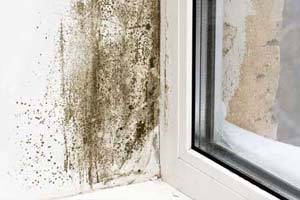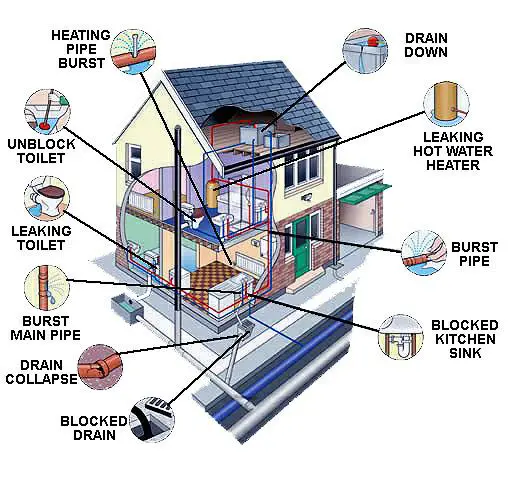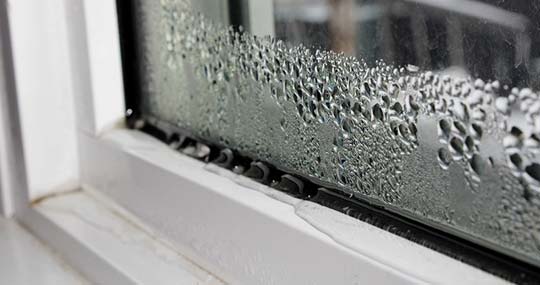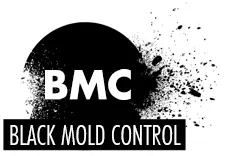How to prevent black mold in your home? Black mold is a potential health risk that can occur inside a home. It can cause allergic reactions, respiratory and vision problems, dizziness, lack of energy and muscle pain. Fortunately, there is something called black mold prevention. Mold only grows when certain specific conditions are met, so if you can prevent these conditions you will be able to prevent black mold.

How does black mold grow?
The most important element necessary for black mold growth is water. This type of mold requires either standing water or a relative humidity of 90 percent or more; therefore, black mold prevention is all about preventing water buildup in the home. There are a multiple ways you can do this.
How to prevent exterior water leaks?
A lot of the time, water that accumulates inside the house actually comes from the outside. It may ooze up from the ground, seep in through the walls or drip in from the roof. To stop this from happening, take the following steps:
Keep gutters and downspouts clear
When gutters are clogged, rainwater builds up in them and eventually spills onto the roof or down the exterior walls. Often, this causes leaks and water seepage that can lead to black mold. The best way to eliminate this issue is to inspect your gutter on a regular basis and clear out any debris that accumulates. If necessary, install gutter guards so that the problem doesn’t occur in the future.
Make sure that downspouts aren’t draining onto the foundation
Even if your gutters are clear, you can have problems if the water is draining too close to the house. It can leak into the basement or wear away at the soil underneath the footings, causing the walls and ceilings to crack. To avoid this problem, make sure that downspouts extend a minimum of ten feet from your house.
Inspect your roof regularly
Significant amounts of water can get into a home through a leaky roof, and you may not notice the leak until it has already resulted in black mold. Because of this, it is important to regularly examine your roof for leaks, especially the valleys, vents and chimney flashing. Replace missing or damaged shingles, trim any trees that are rubbing against the roof, and apply a preservative if needed.
Beware of ice dams
If rain and snow are allowed to continually freeze and thaw on top of your house, ice can collect on the roof and damage it, leading to water inside your house. This problem can be avoided if you keep your roof cold. To do this, make sure that your insulation has an R-value of at least 38 and your ceiling is airtight so that heat doesn’t escape from your home onto your roof.
Properly grade your lawn and yard
If your yard slopes toward your house, you are almost certain to have a flood at one point or another. The water can take weeks to dry out completely, giving black mold plenty of time to develop. Even if your house doesn’t flood, water will accumulate at the foundation, eventually seeping into the house. To stop this process and prevent black mold, make sure that your yard slopes away from your house.
Keep an eye on your irrigation system
Water can get into your home through the irrigation system if the system is too close to your house or if it runs after it has rained. Make sure that your irrigation system is far enough from your house that this doesn’t occur, and install a rain stat so that the water stays off when there has been a rainstorm.
How to prevent interior leaks?
Many times, leaks inside a home can go undetected for long periods of time. Water from these leaks can accumulate quickly, creating a potential black mold problem. The following are some measures you can take so that this doesn’t happen in your home.

- Maintain appliances – Any appliance that uses water has the potential to leak. You can avoid this if you regularly check the drip pans and hoses on your air conditioner and inspect your dishwasher, ice maker and washing machine machine for leaks. In addition, have a professional service your HVAC system and your water heater at least once a year.
- Check for plumbing leaks – Most leaks inside a home come from somewhere in the plumbing system. Inspect your pipes for any sign of dripping, especially under sinks and near the toilet and bathtub. Also, make sure that no water is leaking around the bottom of your tubs or toilets, check your faucets for leakage, and open the toilet tank to make sure no water is leaking under the flapper.
- Be on the lookout for excessive water usage – If you are using more water than usual, you may have an undiscovered leak that could cause black mold. When you get your monthly water bill, make sure that there are no unexplained increases in water usage. If you notice anything unusual, turn off all your water and watch to see if the values on your water meter increase. If they do, you probably have a hidden leak.
- Prevent frozen pipes – When pipes freeze, it often results in mold-causing leaks. To ensure that this doesn’t happen to you, insulate all exposed pipes and make sure that the temperature inside your home never falls below 55 degrees Fahrenheit. In addition, disconnect hoses and turn off your outside water before winter. If pipes do freeze, turn off all water to them and contact a qualified plumber.
- Install water alarms – The sooner you detect water inside your home, the sooner you can fix the problem and prevent black mold. One way to do this is to install water alarms in high-risk places such as underneath sinks. These alarms sound when they sense water, giving you time to take action before damage occurs.
- Consider leak detectors – Leak detectors are different from water alarms in that they actually shut off the water when they sense a leak. They can be installed on individual appliances or the whole house, and they are particularly important for black mold prevention during times when you are not home to see the leaks yourself.
How to increase indoor air circulation?
 A poorly ventilated home can be a breeding ground for black mold. It creates a lack of airflow which can trap humidity and make it difficult for wet areas to dry, causing moisture to accumulate and producing the perfect conditions for black mold. You can prevent this problem if you take the following measures to increase air circulation in your home.
A poorly ventilated home can be a breeding ground for black mold. It creates a lack of airflow which can trap humidity and make it difficult for wet areas to dry, causing moisture to accumulate and producing the perfect conditions for black mold. You can prevent this problem if you take the following measures to increase air circulation in your home.
Ensure that your home is adequately ventilated – In a properly ventilated home, the air pressure inside should be just a little bit higher than the pressure outside. This pushes moisture and mold spores outdoors, helping to prevent black mold. To achieve this condition, make sure that slightly more air is coming into your home than is leaving it. In addition, make sure that there are plenty of vents in your home to help the air escape.
Open windows and interior doors – Allowing outside air to move through your home is a great way to increase air circulation. Not only is it a cheap ventilation method, but outside air is much healthier than inside air. Opening interior doors is also important for air circulation because it ensures that the pressure in your home is even and that every room receives adequate air.
Use fans – Ceiling fans are another way to improve your home’s air circulation, especially during times when you can’t open windows. They also help wet areas to dry, which is important for black mold prevention. If your home doesn’t have ceiling fans, floor or tabletop fans can produce the same result.
Check air filters and ducts – Clogged filters and ducts can make it difficult for air to escape from your home, and they also contribute to poor air quality. These areas should be checked on a regular basis and cleaned or replaced if necessary to help ensure adequate air circulation.

How to control the humidity levels inside your home?
You don’t need to have visible water in your home to develop a black mold problem. High humidity levels also breed black mold, and because they are unseen they can be even more dangerous than standing water. To prevent black mold, you need to keep the humidity levels under 55 percent by:
- Installing fans in high-moisture areas such as the kitchen and the bathroom – Taking showers and boiling water can generate a considerable amount of moisture in your home, and this moisture can raise the humidity levels significantly. Ventilation fans can help that moisture to escape so that you don’t end up with black mold.
- Insuring that your dryer and your stove are vented outside – One of the quickest ways to raise the moisture levels in your home is to vent appliances indoors. These vents release hot, moist air that can create unacceptable amounts of humidity in a home. This can also occur if your hoses leak or your vent is clogged, so check for that as well.
- Covering the floor of your crawlspace with plastic – Wet soil is another thing that can raise humidity levels in your home, and crawlspaces often have dirt floors. When these floors become damp, moisture is released. Plastic creates a moisture barrier that can help to prevent this situation.
- Installing a dehumidifier or a humidifier with a relative humidity sensor – A dehumidifier lowers humidity levels by removing the moisture from the air, which can be especially important in humid climates. If you live in a dry area and must use a humidifier, make sure that it is equipped with a relative humidity sensor that turns the unit off once the humidity reaches 50 percent.
Mold-resistant products for renovation
There are certain home-renovation products designed specifically for the prevention of mold. For example, mold-resistant drywall uses fiberglass instead of paper to keep moisture out. You can use paint that is treated with an EPA-registered fungicide to discourage mold growth on painted surfaces. There is also mold-resistant insulation, wood, trim, caulk, and sealant. Next time you want to renovate your home, talk to your local hardware store about what mold-resistant options are available.
How to prevent mold on closets, clothes and laundry?
There is nothing worse than getting your favorite shirt out of storage, only to find that it has mold on it. However, it can be prevented. The main method of prevention involves keeping your clothes dry. Never hang damp clothing in your closet; always dry your laundry completely before hanging it up. Along the same lines, keep hanging clothes a few inches away from the wall, in case it has condensation. Also try not to keep clothes too tightly packed together, as the fungus can spread from one article of clothing to another.
Black mold can be scary, but it is also preventable. If you pay attention to all discussed areas in your home you should be able to prevent black mold and keep yourself and your family away from this fungus. Your home should be a haven, and you can help to keep it that way through black mold prevention.
